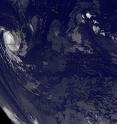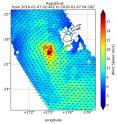NASA analyzes Tropical Storm Ula's winds
Tropical Storm Ula continued to weaken as it pulled farther away from Fiji in the Southern Pacific Ocean. NASA's RapidScat instrument found that the strongest winds in the storm were south of the center. NOAA's GOES-West satellite captured an infrared image of the storm that showed stronger thunderstorms had recently developed around its center. On Jan. 7, 2016 NASA's RapidScat instrument measured surface winds in Tropical Storm Ula and saw the strongest sustained winds near 29 meters per second//64.4 mph/104.4 kph south of the center. Maximum sustained winds are not always equally distributed in a hurricane or tropical storm, winds in the other quadrants were not as strong. RapidScat instrument helps forecasters find the strongest quadrants of a storm. RapidScat is an instrument that flies aboard the International Space Station.
NOAA's GOES-West satellite captured an infrared image of Tropical Storm Ula at 1200 UTC (7 a.m. EST) on Jan. 7, 2016. The infrared image showed that stronger thunderstorms redeveloped in the center of circulation as wind shear relaxed and the storm moved over warmer sea surface temperatures.
At 0900 UTC (4 a.m. EST) on Jan. 6, 2016 Ula's maximum sustained winds had dropped to 45 knots (51 mph/83 kph). Ula continues to track to the northwest at 4 knots (4.6 mph/7.4 kph) and into increasing vertical wind shear, which is expected to keep weakening the storm. Ula was centered near 19.0 degrees south latitude and 175.0 degrees east longitude, about 201 nautical miles (231.3 miles/372.3 km) west-southwest of Suva, Fiji.
The Joint Typhoon Warning Center forecast calls for Ula move toward the northwest and re-strengthen for a day or two before the storm turns to the southwest where it will run into increasing vertical wind shear and move back over cooler waters. Both of those factors are expected to weaken the storm and lead to dissipation by Jan. 10, 2016.
NASA's Goddard Space Flight Center
Source: NASA/Goddard Space Flight Center
Articles on the same topic
- NASA analyzes winds and rainfall in unusual Atlantic system 90LWed, 13 Jan 2016, 19:44:39 UTC
- NASA sees Ula go extra-tropicalWed, 13 Jan 2016, 19:44:22 UTC
- NASA and NOAA satellite data see North Atlantic system more concentratedWed, 13 Jan 2016, 19:44:04 UTC
- Tropical Cyclone Ula's winds, rainfall seen by NASA's GPM and RapidScatTue, 12 Jan 2016, 17:23:05 UTC
- NASA sees Tropical Cyclone Ula's eye closingMon, 11 Jan 2016, 17:51:10 UTC
- NASA sees stubborn Tropical Cyclone Ula kick upFri, 8 Jan 2016, 17:55:48 UTC
- NASA sees Tropical Cyclone Ula weakeningWed, 6 Jan 2016, 17:21:29 UTC
- Tropical Storm Ula weakens, moves southTue, 5 Jan 2016, 19:20:20 UTC
- NASA-NOAA's Suomi NPP satellite sees Ula moving away from FijiTue, 5 Jan 2016, 19:20:03 UTC
Other sources
- NASA sees Ula go extra-tropicalfrom PhysorgWed, 13 Jan 2016, 18:33:04 UTC
- NASA and NOAA satellite data see North Atlantic system more concentratedfrom PhysorgTue, 12 Jan 2016, 20:37:23 UTC
- Tropical Cyclone Ula's winds, rainfall seen by NASA's GPM and RapidScatfrom PhysorgTue, 12 Jan 2016, 18:59:48 UTC
- NASA sees Tropical Cyclone Ula's eye closingfrom PhysorgMon, 11 Jan 2016, 17:41:26 UTC
- NASA sees stubborn Tropical Cyclone Ula kick upfrom PhysorgFri, 8 Jan 2016, 19:44:22 UTC
- NASA analyzes Tropical Storm Ula's windsfrom PhysorgFri, 8 Jan 2016, 0:05:24 UTC
- NASA sees Tropical Cyclone Ula weakeningfrom PhysorgWed, 6 Jan 2016, 16:50:37 UTC
- Tropical Storm Ula weakens, moves southfrom PhysorgTue, 5 Jan 2016, 19:16:01 UTC
- NASA-NOAA's Suomi NPP satellite sees Ula moving away from Fijifrom PhysorgMon, 4 Jan 2016, 17:05:34 UTC
- NASA sees Tropical Cyclone Ula's eye and rainfallfrom PhysorgFri, 1 Jan 2016, 17:02:13 UTC

